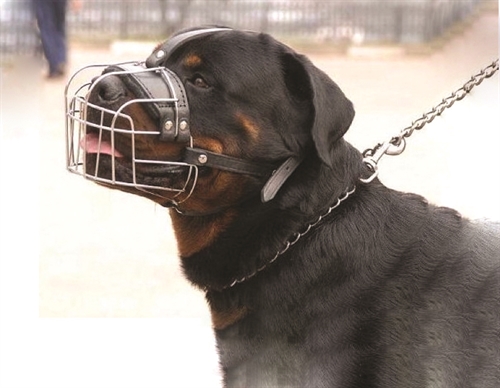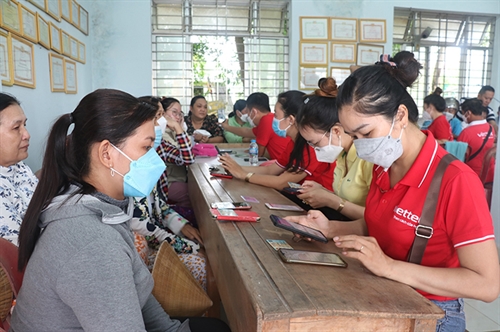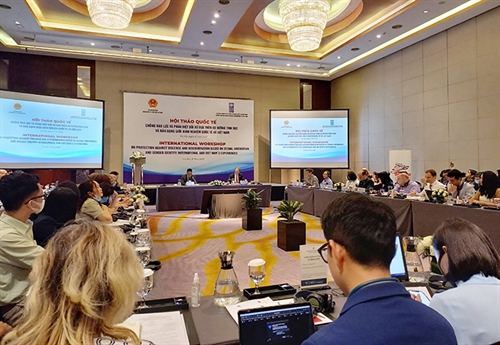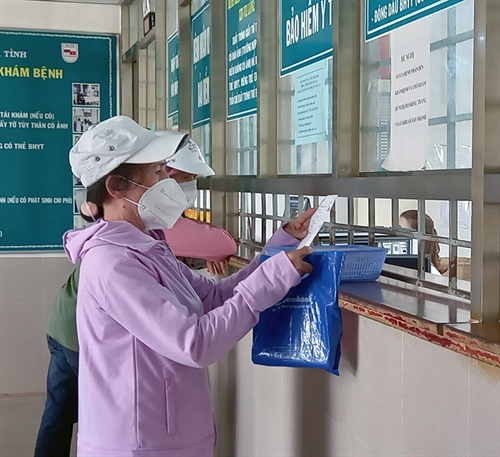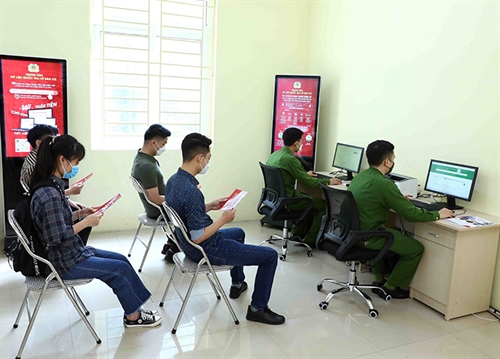 |
| New-generation tobacco products are attractive to youngsters__Photo: Minh Quyet/VNA |
New-generation tobacco products have become popular around the world over the recent years and Vietnam is no exception. But despite being called “tobacco”, these products are not ruled by the current law on tobacco harm prevention and control, making it difficult to manage the trading and use of this special goods item.
Risks concerning new-generation tobacco products in Vietnam
New-generation tobacco products can be classified into two main types: heated tobacco products (HTPs) and electronic cigarettes (e-cigarettes).
HTPs are battery-operated electronic devices that heat processed tobacco leaf to a certain temperature to generate inhalable aerosol containing nicotine and flavor additives. Similarly, e-cigarettes, known as “vapes” or “pods”, are also battery-powered electronic devices that deliver nicotine to users but, unlike HTPs which take nicotine from tobacco leaf, e-cigarettes heat nicotine-containing liquids into a vapor for users to inhale.
Compared to HTPs, e-cigarettes pose greater latent risks. Vaping essential oils might contain thousands of different ingredients, including nicotine, propylene glycol, a substance that will become a carcinogen when heated and vaporized, and vegetable glycerin. More dangerously, it is very easy to add some banned ingredients such as addictive, psychotropic substances to vaping essential oils to increase the users’ stimulation. Therefore, e-cigarettes are considered to be more likely to cause unpredictable consequences on the lifestyle and health of users.
In Vietnam, the emergence of new-generation tobacco products, particularly e-cigarettes, is boosting the rate of smoking, especially among young people. Because e-cigarettes usually come in eye-catching and fashionable shapes and have sleek designs and are advertised to be “modern” and “less harmful”, they are very attractive to youngsters.
Tran Thi Trang, Deputy Director of the Ministry of Health’s Legal Department, said Vietnam is among the 15 countries with the largest number of smokers in the world.
The rate of adult males using e-cigarettes is 5.6 percent, while for adult females, the figure is 1 percent.
“If making a rough comparison, after only five years, the rate of e-cigarette use in Vietnam has increased by 36.5 times for both sexes, 22.75 times for men, and 46 times for women,” Trang was quoted by the Nhan Dan online as saying.
Particularly, the rate of new tobacco users in cities tends to increase, especially among schoolchildren, students and young people.
According to a study carried out in 2020 by the Vietnam Public Health Association, the percentage of people aged 15-24 years in Hanoi and Ho Chi Minh City using e-cigarettes was quite high, reaching 7.3 percent as an overall rate, with 9.1 percent for men and 4.6 percent for women.
Another study on health risk behaviors of secondary school students in Hanoi conducted in 2020 by the Ministry of Health’s Health Strategy and Policy Institute showed that the rate of e-cigarette use was 8.35 percent (4.8 percent for females and 12.39 percent for males) among the 8th-12th graders and 12.6 percent among the 10th-12th graders.
It is necessary to affirm that for the time being, the production and trading of new-generation tobacco products in Vietnam have yet to be officially permitted. However, it is not difficult to buy these products in real stores and online, especially when you are living in big cities like Hanoi and Ho Chi Minh City.
H.T., a salesman of T.V.C., an e-cigarette store chain in Hanoi, revealed that his business provides a wide range of vapes and pods at prices of between VND 350,000 and VND 2 million, exclusive of essential oils. These items are sold not only in real stores but also via social media sites like Facebook, YouTube, Zalo, Instagram, etc.
The availability of e-cigarettes in the market, most of them are untraceable, pose serious health risks to users. In fact, many poisoning exposure cases involving e-cigarettes have been recorded among young people.
In mid-July, the Bach Mai Hospital’s Poison Control Center, Hanoi, received a male patient, aged 22, who was transferred from a lower-level hospital, in the state of cyanosis, convulsions, slurred speech, paranoia, insomnia, hallucinations, anuria, multiple organ system failure, and risk of cardiac arrest. After four days of treatment, the patient was out of the critical condition but still in a coma and remained on mechanical ventilation. Doctors said they found types of synthetic drugs in the vaping essential oil the patient used.
Earlier in April, four 15-year-old schoolboys were admitted to Bai Chay Hospital in the northern province of Quang Ninh with the symptoms of irritability, rapid breathing, sweating, dizziness, nausea, and leg weakness after using e-cigarettes. These boys had never smoked before and just tried e-cigarettes for the first time at the suggestion of friends.
Urgent need for a regulatory framework
It is worth mentioning that since 2020, six e-cigarette stores of the Hanoi-based T.V.C. chain have been handled many times for violations concerning e-cigarette trading but the business continues its operation and even expands its “coverage” to other localities across the country.
Explaining about the situation, Than Duc Cong, an official of the Ministry of Industry and Trade’s Vietnam Directorate of Market Surveillance, said when the Law on Tobacco Harm Prevention and Control was passed in 2012, e-cigarettes had yet to appear. Current legal documents provide for only “tobacco” and tobacco-related violations but mention nothing about the trading of new-generation tobacco products in general and e-cigarettes in particular. In other words, there is no legal basis for treating e-cigarette as a prohibited or restricted item. For that reason, authorities cannot handle violations related to e-cigarettes under the Law on Tobacco Harm Prevention and Control but have to apply other regulations which, however, are seemingly not severe enough to deter violators.
Lets’ take a case in Hanoi as example. The market surveillance force in the capital has recently temporarily seized a shipment of nearly 9,000 e-cigarette products and accessories which was valued at roughly VND 3.7 billion. Although the owner of the shipment failed to produce papers to prove the origin and quality of the goods, authorities could only impose an administrative sanction. As e-cigarettes often bring about a very high profit margin, not a few businesses do not hesitate to trick in this goods item despite of being sanctioned for many times by state management agencies.
To deal with the situation, the Government has assigned the Ministry of Industry and Trade to take the main charge of and join hands with relevant sectors in studying and devising appropriate regulations to manage new-generation tobacco products.
Sharing the Ministry of Health’s viewpoint on this issue, Trang said the Ministry is consistent with the view that Vietnam should not permit, even on a pilot basis, the trading of products which are harmful to people’s health.
“The Ministry of Health proposes putting a ban on all new-generation tobacco products, including e-cigarettes and HTPs,” she said, emphasizing that compared to traditional tobacco, these products have much more great impacts on the health of adolescents and pose high risks of drug abuse.
However, according to experts, before legal documents governing new-generation tobacco products are issued, it is necessary to place such products within the scope of regulation of the Law on Tobacco Harm Prevention and Control so as to restrict the access of young people to these products.-

